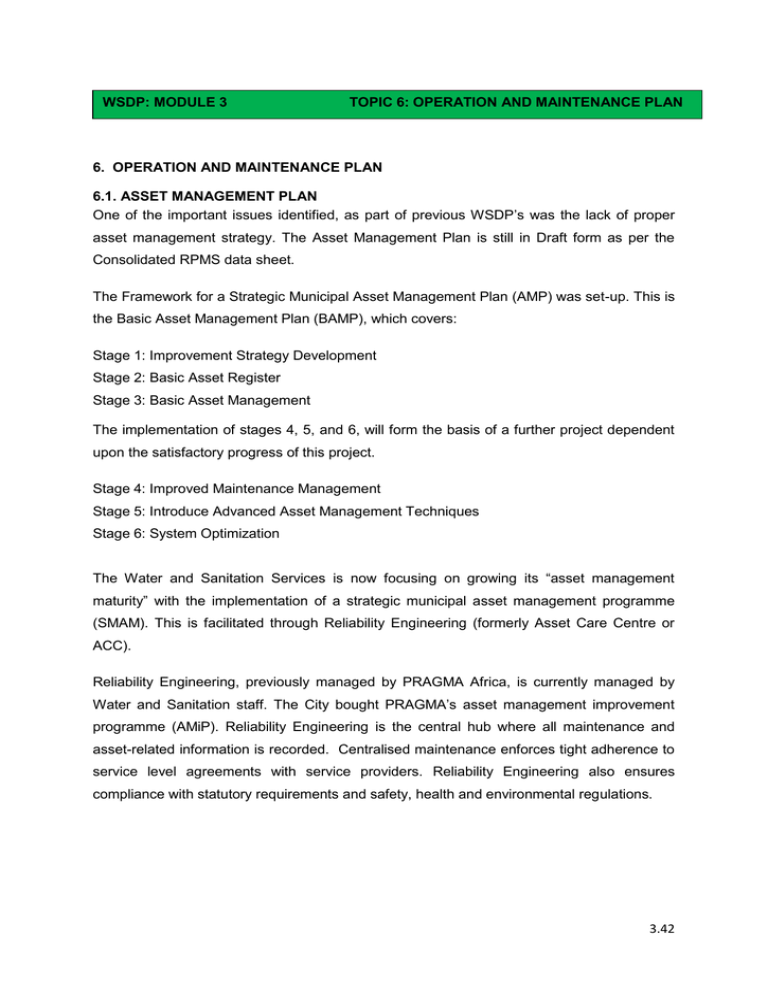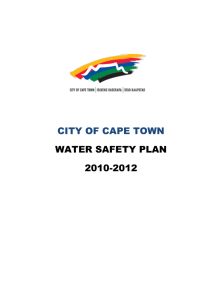Document 10718620
advertisement

WSDP: MODULE 3 TOPIC 6: OPERATION AND MAINTENANCE PLAN 6. OPERATION AND MAINTENANCE PLAN 6.1. ASSET MANAGEMENT PLAN One of the important issues identified, as part of previous WSDP’s was the lack of proper asset management strategy. The Asset Management Plan is still in Draft form as per the Consolidated RPMS data sheet. The Framework for a Strategic Municipal Asset Management Plan (AMP) was set-up. This is the Basic Asset Management Plan (BAMP), which covers: Stage 1: Improvement Strategy Development Stage 2: Basic Asset Register Stage 3: Basic Asset Management The implementation of stages 4, 5, and 6, will form the basis of a further project dependent upon the satisfactory progress of this project. Stage 4: Improved Maintenance Management Stage 5: Introduce Advanced Asset Management Techniques Stage 6: System Optimization The Water and Sanitation Services is now focusing on growing its “asset management maturity” with the implementation of a strategic municipal asset management programme (SMAM). This is facilitated through Reliability Engineering (formerly Asset Care Centre or ACC). Reliability Engineering, previously managed by PRAGMA Africa, is currently managed by Water and Sanitation staff. The City bought PRAGMA’s asset management improvement programme (AMiP). Reliability Engineering is the central hub where all maintenance and asset-related information is recorded. Centralised maintenance enforces tight adherence to service level agreements with service providers. Reliability Engineering also ensures compliance with statutory requirements and safety, health and environmental regulations. 3.42 6.2. STRATEGIC GAP ANALYSIS 6.2.1. Bulk Water Infrastructure Implement the Bulkwater Augmentation Scheme Project Conduct feasibility studies for the Lourens River division project Conduct feasibility studies for the TMG and Cape Flats, and conduct a pilot. Conduct feasibility studies for desalination and reconcile results to the reconciliation strategy Conduct the water- reuse studies and continue with water-reuse projects Upgrade and replace 300km of water reticulation mains (big costly/interruption of supply) Bursts etc., aging network… Construct Contermanskloof, Parklands, Steenbras and Heldeberg reservoirs; Construct a Muldersvlei Treatment Works Upgrade capacity of existing treatment plants Conduct feasibility studies for the rain water harvesting in the City Participate activity in the development and monitoring the Western Cape Security of Water Supply Scheme Strategy 6.2.2. Water and Sanitation Reticulation Infrastructure The Main challenges to be addressed include the access to Water and Sanitation Services by all, reduction in breakdown of services, and facilitate economic development through adequate capacity for services. The strategic interventions shall be: Water: Upgrade and replace 300 km of water reticulation mains. This will be done on the principal of renew and upgrade capacity if possible based on the hydraulic modelling. This shall be mandatory for growth areas and densification chosen areas. Prioritisation of pipes to be replaced shall be based on: The frequency of burst of the pipeline have eliminated the pressure reduction possibility (ie performance based) Water Demand forecast in the next 10 years for condition Assessment results of the section of the pipeline Standardisation of the water network Age profile of the pipeline Results of the hydraulic and water network modelling Material of the pipeline (replacing asbestos) 3.43 Changes in ground conditions To effect this the Manager Reticulation shall : Ensure the Reticulation Branch maintains pipe burst statistics showing the location of burst (by road …. Changes), material of size of pipe, dates, intervention taken, estimated amount of water lost and pressure levels in the pipeline. Classify the reticulation network (sewer and water) areas into critical high, moderate and low performance risk areas and conduct hydraulic modelling for all critical and high risk areas for the purpose of formulating asset replacement plans. Develop Asset Management Plans to be reviewed on an annual basis depending on network performance. Develop Annual Maintenance Plans which shall be the basis for annual asset replacement. No expenditure shall be incurred without the maintenance plans. Research through Water Demand Management and Strategy Branch, new pipe and fitting technology that enhances durability, efficiency, temper proof, environment friendliness and cost effectiveness Develop a Water & Sewer Reticulation Master plan in accordance with the Spatial Development Framework and District Development Plans. Conduct biannual inspections of the functionality of the valves, hydrants, pump stations, reservoirs and pressure reducing valves. Flash out (clean reservoirs on a frequency of five(5)/year Standardise the material specifications, pipe sizes and GPS all assets. Sewer Upgrade and replace ± 200 km sewer pipes based on Condition assessment (CCTV) to be conducted Blockage performance history Grade and hydraulic analysis High water ingression in the sewers Age Replace all cast iron main hole covers with ductile iron or fibre glass material and standardize the sizes throughout the Metro Conduct grade and hydraulic analysis of the sewer network classified as critical and high risk Increase capacity to do regular sewer inspections and cleaning in critical and high risk performance areas. 3.44 Develop an Asset Management Plan and annual maintenance plan Rehabilitate the Macassar and Zandvliet sewer main Education and awareness campaigns on the use and dumping of foreign objects into sewer networks by the public with priorities in Tygerberg, Helderberg, Cape Town and Cape Flats areas which are currently experiencing high levels of sewer blockages due to foreign objects (building materials, fats and others. Develop partnerships with Solid Waste Department. Identify and raise manholes to avoid sand accumulation through wind blowing or sand wash with priority in Cape Town and Helderberg currently experiencing blockages of 51.3% and 24% respectively of total blockages. Informal Settlements Advocate for an integrated ring-fenced approach on the institution arrangements of the Informal Settlements Adopt the following principles in dealing with Informal Settlements: a) Consultation is necessary but not sufficient to address sanitation challenges b) Paradigm shift to community involvement and participation c) Informal Settlements should be considered a “ongoing concern” d) Quality of workmanship and durable technology and materials e) Housing Department is the landlord for Informal Settlements 6.2.3. Asset Management It is essential for water services authorities to protect their assets by ensuring that an appropriate maintenance and rehabilitation plan is developed and implemented. This plan must be based on the principle of preventative maintenance in order to ensure that, as far as this is practical, damage to assets is prevented before it occurs. The water services authority must ensure that the maintenance and rehabilitation plan is part of the water services development plan and that this plan is implemented. Assets must be rehabilitated and/or replaced before the end of their economic life and the necessary capital funds must be allocated for this purpose. Asset Condition Assessment Tender is underway. The gap relates to capacity and skills: Capacity is required to ensure that the relevant skills are obtained so that the service graduates to Improved Maintenance Management. 3.45 6.2.4. Implementation strategies (water services infrastructure) 6.2.4.1. Strategy for Growth areas A partnership approach with developers was started to ensure that development could continue. The targeted areas are: West Coast / Parklands development corridor De Grendel / N7 development node Northern development corridor Bottelary development corridor Fast-track housing projects (e.g. N2 Gateway) Maccassar / AECI development node 6.2.4.2. Strategy for Wastewater Treatment Works The strategies for ensuring that wastewater treatment capacity is sufficient are: Integrate planning for new works and extensions with the other branches and ensure that additional wastewater treatment capacity is provided where needed at the right time Pro-active maintenance of all mechanical and electrical equipment as well as civil structures as part of the Asset Management Strategy Process optimisation Improved monitoring and operational control 6.2.4.3. Strategy for Bulk Water Infrastructure The Bulk Water Augmentation Scheme must be implemented to avoid peak week water demand from exceeding the available supply capacity, which would result in water restrictions having to be implemented during peak demand periods. The Contermanskloof and Steenbras bulk reservoirs are required to address supply constraints in certain sections of the water supply network. To cater for the growth in demand in the northern areas there are plans and budgets for the implementation of the Northern Areas Bulk Water Augmentation Scheme. 6.2.4.4. Strategy for Long Term Integrated Planning To ensure more effective long term integrated planning within Water and Sanitation Services, consultants are busy finalising the Master Planning (Bulk water, Bulk Waste water and reticulation) for the whole City. 3.46 Reference should be made to the Bulk Water, Wastewater Treatment and Reticulation Master Plans mentioned previously. 6.2.4.5. Strategy for Asset Management The strategy is to move the entire Water and Sanitation Services Department up the levels of maturity in accordance with the AMIP (Asset Management Improvement Plan). A Reliability Engineering structure which will focus on CIP (Continuous Improvement Programme) has been agreed; it needs to be capacitated. This will enable water and Sanitation to be able to look beyond maintenance to condition based maintenance which is critical for most of the rotating equipment. 3.47






